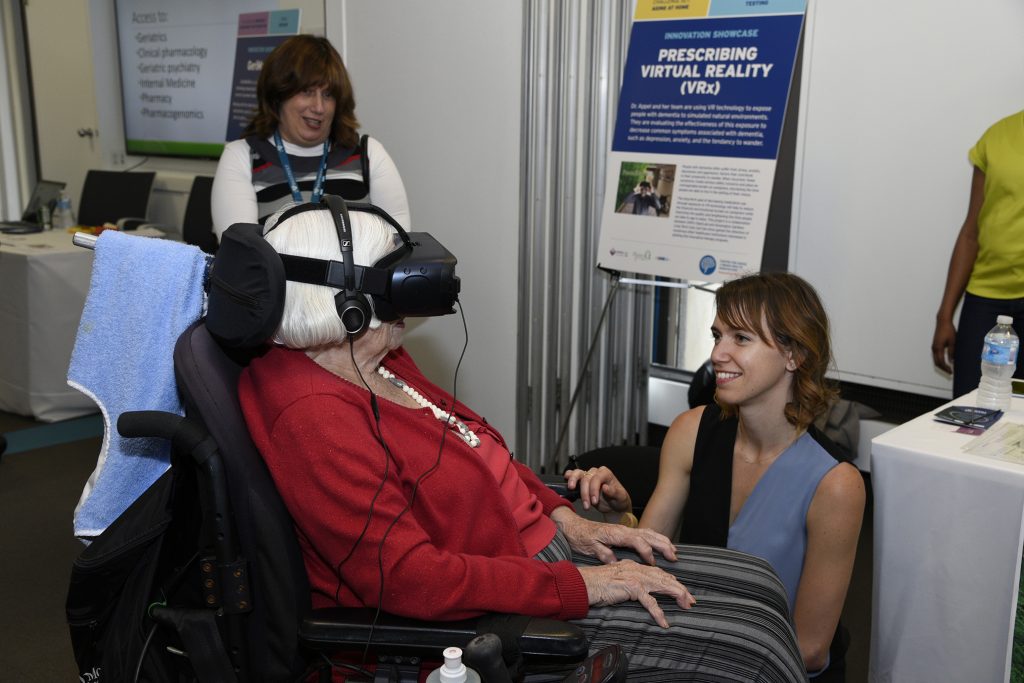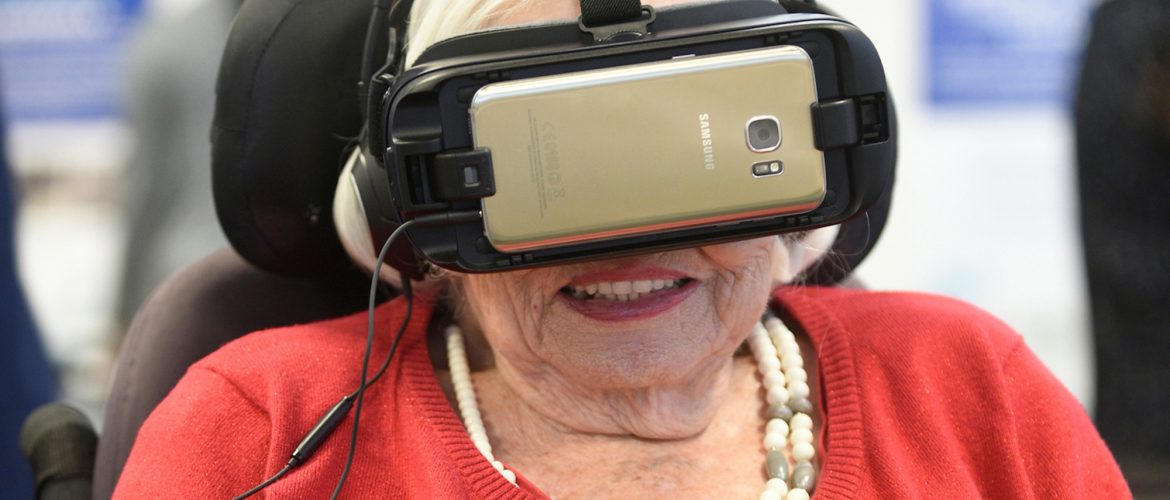Imagine walking into a long-term care facility where residents living with dementia have access to headsets that immerse them into a peaceful forest. This reality might not be that far off.
Some hospitals are already integrating virtual reality (VR) for various purposes – be it to educate healthcare workers, provide entertainment or sooth patients dealing with anxiety. But when it comes to people living with dementia – a population that’s on the rise, numbering more than half a million people in Canada alone – we’re still at the tip of the iceberg for integrating VR into their care.
Researchers such as Lora Appel, who has a PhD in health informatics and specializes in applying technologies into different aspects of healthcare, are busy studying the impact of virtual reality on patients with dementia. Working out of the University Health Network’s OpenLab, Appel’s project is evaluating whether simulated natural environments decrease stress, anxiety and the desire to wonder in this population.
“Virtual reality is very hot, innovative and upcoming,” says Appel. “I mean, it’s been around for a long time, but in it’s most recent incarnation it’s both more affordable and reaching a place where it’s getting to be more user-friendly.”

Laura Appel helps an older adult try a virtual reality headset during CABHI’s Innovation Showcase.
Appel wanted to study a population that was often unable to reap the benefits of nature, be it for physical or cognitive reasons. It’s no secret that people living with dementia are sometimes confined to long-term care facilities or their homes partly because they’re no longer able to navigate their communities independently.
“There’s been some applications of virtual reality in healthcare – mostly phobia treatment and post-traumatic stress disorder. But the idea of testing it with a very difficult population like those that are cognitively impaired – if we can do that and prove that they tolerate the headset, we can be more confident that we can use it with different patients.”
So what has Appel found? She’s in the midst of publishing her feasibility study, aptly titled Prescribing Virtual Reality. One of her major concerns was whether people with dementia would tolerate the VR headsets. “We have definitely more detailed analyses that we’ll report on, but I’d say that’s a very overall positive finding. The hardware doesn’t seem to bother them.”
She also revealed an unintended outcome. “That’s the fact that VR seems to elicit conversation around memory, which intuitively makes sense. You see something and you kind of relate it to your personal experience. But we thought you’re going to get benefits from being outside in nature. And then for this population that have issues with memory, the fact that it makes them talk about past memories – maybe we can use this as a trigger in the future to kind of elicit moments of lucidity where they can remember their past.”
However, Appel is quick to suggest this topic requires more research. In fact, she says one of the reasons many long-term care facilities are likely not using VR is because there still isn’t a ton of evidence for its use with this population.
“The study that I’m running now is a feasibility study and we hope that once this is complete, since we have had positive outcomes, to do a more rigorous randomized control trial. These are studies that would guarantee that people who are randomly assigned to getting virtual reality vs. another therapy – if there are actually benefits.”
Appel, who received financial support through the Baycrest-led Centre for Aging + Brain Health Innovation (CABHI), says organizations like CABHI are vital for moving these technologies forward. Project funding and support came from CABHI’s Spark Program for early-stage innovations. Kensington Health, Baycrest and Bitove Centre for Memory Loss and Aging participated as trial site partners to the VR project, helping to evaluate the effectiveness of the therapy with a real clinical population.
“Without this funding from CABHI, the feasibility study would not have taken off,” Appel says. “They’ve been supportive and always asking how they can be of greater help.”
Prescribing VR is now ready to begin more advanced testing, with additional CABHI support. Appel successfully applied to CABHI’s Researcher-Clinician Partnership Program (RCP2), which provides the opportunity to test and validate solutions in real-world care settings. Building on the CABHI-funded pilot study through the Spark Program, Appel and her team improved the VR therapy and now plan to conduct a large randomized controlled trial that will test in greater detail how aging adults are affected on a physiological and clinical level.
Meanwhile, the project is making waves in the research world. Last month Appel was invited to the Virtual Reality and Healthcare Symposium at Harvard Medical School, where she presented her findings.
“I can confidently say we are still are the forefront of research in this area. While many experts raise theoretically the potential for VR to positively impact senior care, very few groups are actively placing headsets on individuals diagnosed with dementia,” she says. She believes her team is among the first to evaluate the phenomenon this rigorously.
“These RCP2 trial outcomes, if positive, will ensure that VR has a place in medical therapies in the future,” Appel says. “But as of the present, I’m rewarded by the emails I get from family and caregivers describing how the VR experience has benefited their loved one.”

Attendees of CABHI’s Innovation Showcase try the VR Dementia Simulation project.
Sandra McKay, VHA Home HealthCare’s manager of research and evaluation, echoed Appel’s thoughts. Her exploratory study, which also received support from CABHI, looks at VR’s effectiveness as a tool for caregivers to manage symptoms like aggression and agitation in the home.
“Myself personally as an academically trained researcher, I had a lot of questions,” admits McKay. “I had many concerns. There wasn’t a lot of available evidence – particularly when you consider that we were asking families potentially to use rather sophisticated devices independently in the home.”
The study, which came after a point-of-care staff suggested using VR to support families, involves providing caregivers with a VR headset and a catalogue of videos for two weeks. If they end up using the technology, family members are asked to document the nature of the situation and the outcome. It’s still in the recruitment stage. However, McKay says that out of all the studies she’s worked on in her decade-spanning career, this one is garnering the most interest.
She adds that one of the biggest misconceptions is the notion that VR headsets are expensive. “What is expensive is the phone and the data plan that need to accompany the headset. So that’s the catch. People sometimes say, ‘Oh, it only costs $100 for the headset, terrific.’ But you must have a Samsung Galaxy phone that to purchase is approximately $700, and then the data plan. So that’s where it becomes cost prohibitive,” she says, adding that older models and second-hand phones can be used to reduce costs.
But what if you wanted to create original, tailored content? That’s certainly possible. Digital Generals’ Terry Myers helps a number of healthcare organizations create compelling VR experiences. One of his latest projects, in collaboration with Baycrest Hospital and CABHI, uses VR to educate and create empathy for caregivers of people with Alzheimer’s.
“Are you able to feel empathy for what they’re doing? The results say yes; people can feel empathy. We had users crying in the headset. We had people who would come out and just pour their hearts out to us about how it made them feel in a positive, but also very intense way,” says Myers, adding that no two projects are the same and can range from just $2,000 to five or six digits.
He says the work being done in collaboration with CABHI is vital, adding that it’s helping to answer questions related to return on investment and whether the technology is an effective education and therapy tool for dementia. “There’s no other avenue for the financial support to get this started,” says Myers.
While we’re still in the early stages of VR use in relation to dementia, Myers is a strong advocate for the medium. “The technology is just incredibly powerful. It’s kind of beyond anything that we’ve been able to use to talk to people, share stories and create feelings. It’s a very exciting space to be in and I think healthcare is a natural fit for it.”


